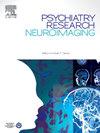诊断为强迫症的儿童和青少年与健康对照的视网膜神经网络参数比较:一项横断面研究
IF 2.1
4区 医学
Q3 CLINICAL NEUROLOGY
引用次数: 0
摘要
强迫症(OCD)是一种慢性精神障碍,通常开始于儿童或青少年,与皮质-纹状体-丘脑-皮质回路的功能异常有关。鉴于强迫症的神经发育基础以及视网膜与中枢神经系统之间的解剖和生理关系,近年来的研究重点是利用光学相干断层扫描(OCT)研究神经精神疾病的视网膜变化。然而,关于儿童强迫症人群视网膜结构变化的数据很少。本研究的目的是通过比较oct衍生的测量结果与健康对照,调查诊断为强迫症的儿童和青少年视网膜结构可能的差异。本研究比较了33名儿童强迫症患者和45名健康对照者的乳头周围视网膜神经纤维层(RNFL)厚度、神经节细胞层(GCL)体积、GCL厚度、神经节细胞复合体(GCC)厚度和中央黄斑厚度(CMT)。采用社会人口学数据表、莫兹利强迫问卷(MOCI)和儿童焦虑及相关障碍筛查(SCARED)。OCT成像测量RNFL、GCL体积、GCL厚度、GCC厚度和CMT。结果显示,强迫症组的CMT值明显低于健康对照组,而GCC值较低,但差异不显著。OCT测量值与量表得分无相关性。这项研究首次对儿童强迫症患者的视网膜测量进行了研究,表明未来的研究应该进一步探索两者之间的潜在关系。本文章由计算机程序翻译,如有差异,请以英文原文为准。
Comparison of retinal neural network parameters of children and adolescents diagnosed with obsessive compulsive disorder with the healthy controls: A cross-sectional study
Obsessive Compulsive Disorder (OCD) is a chronic psychiatric disorder that often begins in childhood or adolescence and is associated with functional abnormalities in cortico-striato-thalamo-cortical circuits. Given the neurodevelopmental basis of OCD and the anatomical and physiological relationship between the retina and the central nervous system, recent studies have focused on investigating retinal changes in neuropsychiatric disorders using Optical Coherence Tomography (OCT). However, data on retinal structural changes in pediatric OCD populations are scant. The aim of this study was to investigate possible retinal structural differences in children and adolescents diagnosed with OCD by comparing OCT-derived measurements with healthy controls. This study compares the Peripapillary Retinal Nerve Fiber Layer (RNFL) thickness, Ganglion Cell Layer (GCL) volume, GCL thickness, Ganglion Cell Complex (GCC) thickness, and Central Macular Thickness (CMT) in pediatric 33 OCD patients and 45 healthy controls. A sociodemographic data form, Maudsley Obsessive Compulsive Questionnaire (MOCI) and Screen for Child Anxiety and Related Disorders (SCARED) were applied. OCT imaging was performed to measure RNFL, GCL volume, GCL thickness, GCC thickness, and CMT. Results showed that the CMT was significantly lower in the OCD group compared to the healthy controls, while the GCC value was lower but not significantly different. No correlation was found between OCT measurements and scale scores. This study is the first to investigate these retinal measurements in pediatric OCD, suggesting a potential relationship that future studies should explore further.
求助全文
通过发布文献求助,成功后即可免费获取论文全文。
去求助
来源期刊
CiteScore
3.80
自引率
0.00%
发文量
86
审稿时长
22.5 weeks
期刊介绍:
The Neuroimaging section of Psychiatry Research publishes manuscripts on positron emission tomography, magnetic resonance imaging, computerized electroencephalographic topography, regional cerebral blood flow, computed tomography, magnetoencephalography, autoradiography, post-mortem regional analyses, and other imaging techniques. Reports concerning results in psychiatric disorders, dementias, and the effects of behaviorial tasks and pharmacological treatments are featured. We also invite manuscripts on the methods of obtaining images and computer processing of the images themselves. Selected case reports are also published.

 求助内容:
求助内容: 应助结果提醒方式:
应助结果提醒方式:


